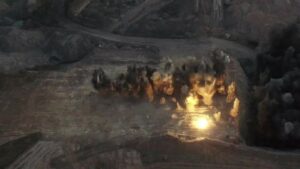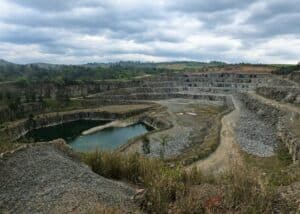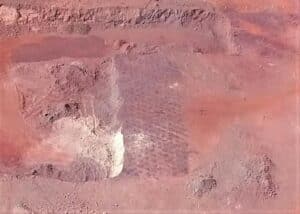
Improving Fragmentation And Loading Rates Through Better Blasting With Varistem®
The intent of the trial was to demonstrate the energy retention capabilities of the Varistem® blast stemming plugs through conducting a split blast on a
The intent of the trial was to demonstrate the energy retention capabilities of the Varistem® blast stemming plugs through conducting a split blast on a production waste bench at a manganese mine in South Africa. The main results considered were to determine the difference in blast energy retention when using Varistem® with drill chippings as compared to using only drill chippings as stemming material (non-Varistem®). This was done through a visual analysis of the blast, a physical fragmentation analysis as well as the measurement of loading rates of the material.
The overarching methodology that was used was as follows:
The relevant blast parameters for the trial blast are shown in Table 1, with the bench layout and camera positioning shown in Figure 1, and further bench layouts from multiple angles in Figure 2.
Table 1: Trial Blast Parameters
| Metric | Detail |
| Blast Type: | Waste Lower Lime/Calcrete |
| Geology: | Uniform throughout the block |
| Holes on blast: | 1 343 holes |
| Burden and spacing: | 4.3m x 5.0m (14.1ft x 16.4ft) |
| Drill Depth: | varied 15m (49.2ft) |
| Stemming Depth: | 2.5m (8.2ft) |
| Powder Factor: | 1.345 |
| Stemming Material: | Configurations of Drill Chippings; and Varistem® & Drill Chippings |
| Blast Timing: | 25ms between holes, 170ms between rows (Identical East & West Side) |
| Drill Pattern: | Staggered |
Figure 1: Blast Bench Layout and Camera Positioning
Figure 2: Blast Bench Layout – Multiple Angles
The visuals from the South (Figure 3 and Figure 4) (in conjunction with the visuals from the North, not shown in this article) clearly indicate an increase in time to stemming movement as well as a reduction in the number, violence and velocity of blowouts. This shows that the Varistem® stemming plugs improved the energy retention on this blast, when considering the visual result in isolation.
Figure 3: Visual Analysis Outtakes – South
Figure 4: Visual Analysis Outtake – South Thermal
RESULTS – FRAGMENTATION IMPROVEMENT
Figure 5: Ortho Muckpile View
Note the difference in the alignment of the muckpile peak (Figure 5), and power trough between the Varistem and Non-Varistem side. A uniform peak alignment indicates better energy distribution, while a wider power trough indicates improved energy retention. Figure 6 and Table 2 show the particle size distribution data from the fragmentation analysis that was conducted for the trial blast.
Figure 6: Particle Size Distribution Curve – Varistem vs. non-Varistem
Table 2: Particle Size Distribution – Percentage Passing
| Without Varistem® | With Varistem® | |
| % Passing | Size[cm] | Size[cm] |
| P10 | 0,22 | 0,05 |
| P20 | 1,01 | 0,48 |
| P30 | 2,3 | 1,42 |
| P40 | 4,18 | 2,87 |
| P50 | 7,1 | 4,91 |
| P60 | 10,72 | 7,74 |
| P70 | 15,51 | 10,49 |
| P80 | 24,02 | 13,41 |
| P90 | 38,06 | 17,43 |
| Topsize | 84,79 | 27,76 |
From the fragmentation results in Figure 6 and Table 2, it is evident that the fragmentation results on the Varistem® portion of the trial bench were far superior to that of the non-Varistem® portion of the bench:
Table 3: Load and Haul Trial Data
| West – Varistem® & Drill Chippings | East – Drill Chippings | |
| Data points | ||
| Day Shift | 17 | 21 |
| Night Shift | 20 | 21 |
| Data Totals | ||
| Day Shift | 8 036 | 9 345 |
| Night Shift | 10 898 | 10 586 |
| Average BCM/hour | ||
| Day Shift | 472,71 | 445,00 |
| Night Shift | 544,90 | 504,10 |
| Combined | 511,73 | 474,55 |
Figure 7: Loading Rates – Varistem vs. Non-Varistem
In line with the overall intent of the trial, the following conclusions can be made:

The intent of the trial was to demonstrate the energy retention capabilities of the Varistem® blast stemming plugs through conducting a split blast on a

Introduction With chemical energy still being one of the most cost-effective means to reduce the size of rock to liberate strategic minerals and metals, blasting

Varistem® Blast Stemming Plugs Trials Iron ore fragmentation plays a crucial role in the efficiency of mining operations, directly impacting the performance of processing plants.